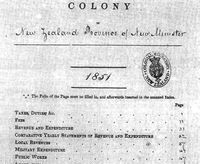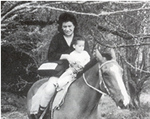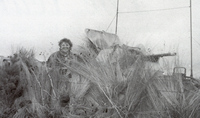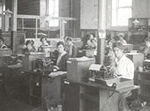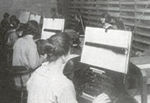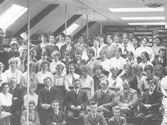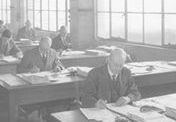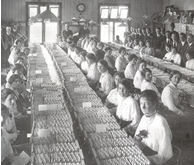NZHistory.net.nz / Gallery / Working with Statistics
Working With Statistics
Beginnings
Statistical work has always meant collecting, analysing and presenting
data. Only how this is done and the types of data collected have
changed. In New Zealand's early colonial years, officials such as
magistrates and policemen collected information about people and
economic activities in the course of their duties. A few male clerks in
the Office of the Colonial Secretary put this data together, and
summarised the results on standardised forms which were bound together
in volumes known throughout the British Empire as 'Blue
Books'. Annual statistical reports were published from the 1850s,
and from then on much effort went into checking and rechecking proofs
from the Government Printer.
For a century from the 1890s, the New Zealand Official Yearbook
was the main way by which statistical information was presented to the
public. Many staff coordinated, updated and checked the material
contributed by other government departments. In recent years much of
this information has been made available online.
�
Collecting data
Censuses of people (and animals) required much effort. Initially, men
with close knowledge of their communities, such as police and post
office workers, collected data on the ground. Pre-motorised travel was
hazardous, and at least one sub-enumerator suffered 'the New
Zealand death', drowning while crossing a river on horseback. In
the early twentieth century, agents such as grocers distributed family
budget surveys. Later, information was increasingly collected by post
as comprehensive coverage was replaced by sample surveys. Census forms
are still delivered to every household in the country, however, and by
a wide variety of methods.
�
Tabulation techniques
As both New Zealand's population and the complexity of the
information sought grew, so did the size of the army of temporary
clerks that was employed every five years by the Census and Statistics
Office to process it. Sitting at long tables in large draughty or
cramped rooms, they laboriously added, subtracted and calculated
percentages. From the 1890s census data was written on cards which were
sorted by hand. The drudgery of statistical work was gradually eased as
adding and calculating machines and typewriters came into use, operated
mostly by women. Tabulating machines were imported from the United
States in the 1920s to process punched cards; this too was
women's work.
�
The introduction of computers
The Census and Statistics Office employed a few economists, including
the well-known J.B. Condliffe, after the First World War, but no fully
qualified mathematicians until after the Second, when in-house training
in statistical methods also began. By the 1960s the population census
had barely been processed by the time the next one was taken five years
later. Statistics acquired a second-generation IBM mainframe computer,
but this was soon obsolete, and the Government Computer Centre was
unable to process statistics such as the Consumers Price Index quickly
enough. Since the early 1980s computing has been done in-house, and in
the 1990s personal computers and the Internet revolutionised the
day-to-day experience of work at Statistics New Zealand.
�
Working conditions
New Zealand's statistical workers have enjoyed (or endured) a
wide variety of working conditions over the years.
'Highlights' have included the obsolete parliamentary
boiler house; the 'dirty, dank and unsanitary hole' of the
Wairarapa Farmers' Co-operative Association, which was shared
with a thriving rat population; and the attic of the Public Trust
building. Newer accommodation wasn't always much better: the
concrete Hood's building between Lambton Quay and The Terrace in
Wellington was state-of-the-art for 1925, but staff either shivered in
the 'Dungeon' or sweltered on the 'Sunnyside';
the window frames soon leaked and let through draughts, and the
plumbing 'went on the blink'. After decades in a growing
number of rented offices of varying quality, head office at last became
'comfortably housed' when it moved into Aorangi House in
Wellington in 1974.
�
Extra duties
Statistics staff have sometimes taken on additional duties. During the
First World War, for example, several hundred temporary staff, mostly
women, compiled information on every male of military service age, and
carried out the periodic birthdate ballots for conscription. In the
Second World War these duties were taken over by a separate National
Service Department.
�
Staff having fun
There has always been play as well as work. A table tennis craze in the
1920s was short-lived, but sport, picnics and office parties have
endured. In 1956, the newly-created Department of Statistics had only
92 male and 72 female employees. By 2000 there were nearly 900 staff,
more than half of them based outside Wellington. The balance of the
sexes is now virtually even.
�
Back to top
Exhibition author: David
Green
Webpages:
Copyright © Ministry for Culture and Heritage, Wellington, New
Zealand
Copyright and disclaimer information for
this website.
